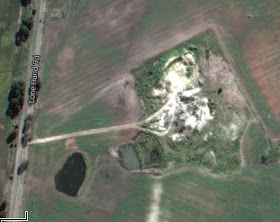Today, Allendale (approximately 25 km
north of Ballarat) is a far cry from its peak back in the days of the gold rush
of the 1850’s. Once a thriving service centre for the mining industry,
the scattered remnants tell us little of the past. In fact, once Allendale was
four adjoining towns in one; Allendale, Wallace Town, Ryans Town and Ristori
Town, named after Adelaide Ristori (1822-1906) a famous Italian actress in her
day. She toured Australia in 1875. Now the demarcation between the
towns, and most of the towns themselves, are long gone. Once a thriving
settlement of over 1500 people, the town boasted a variety of facilities needed
to maintain a thriving and profitable mining industry. Allendale is now
greatly reduced, but back in the day, it was a centre for gold miners, having
six hotels, a museum and their own fire brigade.
Into this community came Robert
Selkirk. Born in Fife, Scotland in 1819, he migrated to Victoria in 1854
with his family, including Robert Selkirk II who was also born in Fife, in
1841. Robert Jnr worked as a stonemason for years before making bricks in 1883
by hand at Allendale, just outside Ballarat. RS2 gave up stonemasonry for
timber splitting and moved to Cherry-Tree Flat near Ross Creek. Later, in 1883 on his return to Allendale,
he took up brick laying, but saw the demand for bricks in the growing
town. He had discovered suitable clay
deposits behind his house in Allendale and by 1892, he had given up bricklaying
and was a full-time Brickmaker. He and
one other worker built a drying shed, a clamp and wooden moulds and began
production. Robert eventually owned three properties around Allendale,
two used for brick making and one for his home in Elizabeth Street with the
works nearby. Eventually, he employed
ten workers who also made roof tiles and drainage pipes.
He first made bricks from clay in a field
in Ristori Town. This was dug from the
banks of mullock heap left at the Ristori mine in the De Murza paddock. The clamp could produce up to 6,000 bricks
per week. These bricks were too soft
after firing so he moved extraction to a new location. Even though he considered these bricks too
soft, they have lasted over a century.
He then made bricks from clay behind his house in Elizabeth Street. By 1892, Robert moved to new premises around
the corner in Garfield Street Allendale and had mechanised production through
two scotch kilns. Known as “Selkirks
Brick Tile and Pipe Works”,
By 1887, bricks were being sent by rail
to several destinations. The delivery
waggon, still catered to the local market.
By 1900, mining in Allendale was in rapid decline but Robert still had
enough money to purchase land in Howitt Street in Ballarat. Robert had
seen the clay on the hillside there during his delivery trips. He purchased
10 acres of land known as “Heinz’s Paddock” and the business relocated there in
March 1900. Robert offered the old clay
pit to the local Creswick Shire Council to use as a rubbish dump, but they
declined because it was too close to the town.
It is still there today.
He built a Hoffman kiln in Ballarat from
the last of his bricks made at Allendale. It took over 400,000 bricks to
make it and it had a capacity of 6.000.000 bricks per year. Distribution
through the nearby railway enabled the company to grow.
Today, Selkirk’s make 50,000,000 bricks
each year, as well as other clay products and I believe that only one Selkirk
remains with the company. But this story is about the brick works in
Allendale. Even though he made thousands of bricks there, today, only two
buildings remain that were made from his original bricks. An old bakery,
next to the nursery was made from his later Allendale bricks, and a kitchen
with a chimney at the back of a weatherboard house is the only building made from
the first works. His bricks are scattered everywhere though. Little
piles in people’s gardens, garden edging and the occasional driveway are all
that’s left. This one was given to me by Ben, a long time resident, who
also gave me some of this information.



No comments:
Post a Comment